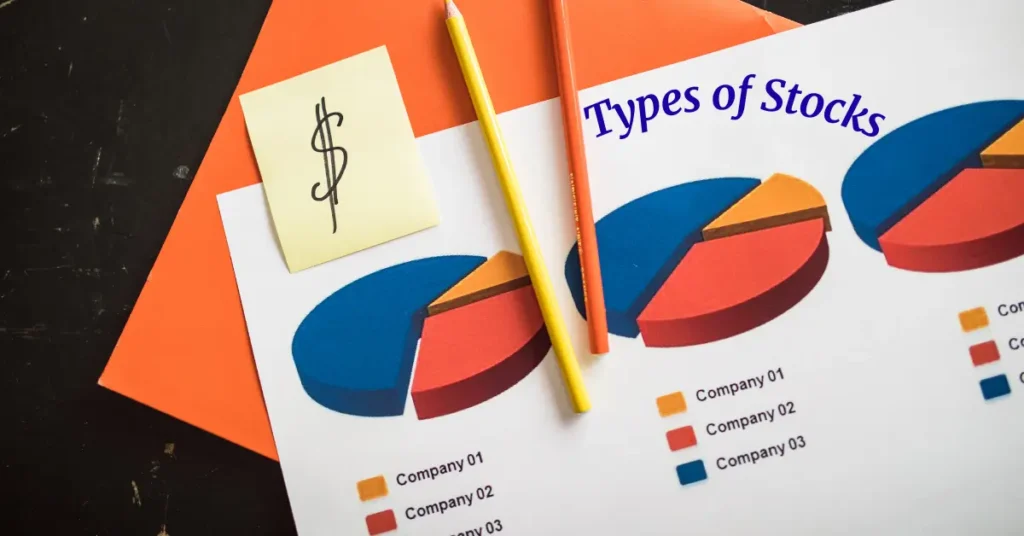Follow Us
What are the Different Types of Stocks to Invest in?

Table of Contents
Basics of the Stock Market
So, what exactly is the stock market? At its core, it’s a vibrant marketplace where shares of publicly held companies are bought and sold.
Stocks are more than just pieces of paper or digital numbers flashing on a screen; they are fundamental to how the financial world operates.
Owning a stock means you own a piece of a company. If the company thrives, so does your investment.
And as millions of investors make decisions based on company performance, global events & economic indicators, they drive the backbone of the market’s daily activity.
This bustling exchange does more than just facilitate the trading of stocks. It plays a pivotal role in allowing companies to raise capital, thereby fueling economic growth and innovation.
Every buy or sell decision contributes to this dynamic ecosystem, influencing everything from the top tech companies to the brands populating your pantry.
Related Article:
How Does the Stock Market Work?
What Are Stocks?
Let’s break it down: stocks are essentially small pieces of a company. When you buy a stock, you’re buying a slice of ownership in that company.
This ownership comes with potential profits through dividends and price appreciation, as well as certain rights like voting on major company decisions.
Stocks play a dual role. For companies, they are a way to raise money without incurring debt. Instead of borrowing, a company can sell shares to the public.
For individuals, stocks are a tool for building wealth, potentially outpacing inflation and increasing savings over time.
Now, how do stocks stack up against other investment vehicles like bonds or mutual funds?
Unlike bonds, which are loans to the government or companies with a fixed return, stocks offer potentially higher returns, albeit with higher risk.
Mutual funds, on the other hand, bundle various stocks, bonds, or other assets, offering diversification and managed risk but often with fees that can eat into profits.
So, while stocks might carry more risk, they also hold the promise of greater rewards, which is why they’re a cornerstone of many personal finance strategies.
Classification of Stocks
Common Stocks vs Preferred Stocks
When it comes to stocks, not all are created equal. The two main types you’ll encounter are common stocks and preferred stocks.
Each comes with its own set of features and benefits.
Let’s lay them out in a simple table to help you see the differences clearly:
| Type | Definition | Examples | Pros | Cons |
| Common Stocks | Shares that represent ownership in a company & confer voting rights. | Apple, Tesla | – Voting rights – Potential for high returns through capital appreciation | – Dividends not guaranteed – More vulnerable in bankruptcy |
| Preferred Stocks | Shares that offer no voting rights but generally provide fixed dividends & priority during payouts. | Wells Fargo Preferred Stock, AT&T Preferred Stock | – Fixed dividends – Priority in asset liquidation | – Limited growth potential – No voting rights |
Common Stocks:
Common stocks are what most people think of when they invest in the stock market. As a shareholder, you get to vote at shareholder meetings and share in the profits of the company through dividends and stock price increases.
However, if things go south, common stockholders are the last to receive any payouts, standing behind creditors and preferred shareholders.
Preferred Stocks:
Preferred stocks are a bit like the hybrid car of the stock world. They offer fixed dividends, which makes them similar to bonds, and you’re ahead of common stockholders if the company liquidates its assets.
However, you won’t get voting rights, which means less control over corporate decisions. Plus, the price appreciation potential is generally lower than that of common stocks.
Growth Stocks
Growth stocks are like the tech startups of the stock market, fast-growing, potentially highly profitable, but with a touch of risk.
These are shares of companies that reinvest their earnings to accelerate growth in the short to medium term.
Think of companies like Amazon and Tesla in their early days, where the focus was on rapid expansion and innovation.
Characteristics:
- High Growth Rates: These companies often grow faster than the overall market or their peers.
- Reinvestment: Instead of paying dividends, they reinvest earnings to fuel growth.
- Innovation-Driven: Many are in technology, renewable energy, or cutting-edge sectors.
Examples:
- Tech Giants: Companies like Google and Apple were once growth stocks that kept scaling new heights.
- Biotech Firms: Moderna, for instance, surged due to its innovation in vaccine technology.
Value Stocks
Value stocks are the market’s hidden gems. Investors who prefer value stocks are essentially looking for deals, betting on stocks that are currently underpriced relative to their intrinsic value.
What Makes a Stock a “Value Stock”?
A value stock is typically characterized by lower price metrics, such as price-to-earnings (P/E) ratios, price-to-book (P/B) ratios, and other comparative measures. These stocks are often associated with companies that:
- Have fallen out of favor but still have strong financials.
- Offer dividends that are higher than average.
- Are in industries that might currently be undervalued due to economic cycles.
Identifying Value Stocks in the Market
Finding value stocks requires a keen eye for detail and a penchant for digging deeper than the average investor. Here’s how you can spot them:
- Look for Low Price-to-Earnings Ratios: Compare the P/E ratios with industry averages. A significantly lower P/E ratio may indicate a value stock.
- Examine the Dividend Yield: Is the dividend yield higher than what similar companies offer? If yes, you might have found a value stock.
- Assess the Company’s Fundamentals: Check financial statements for strong fundamentals, such as solid cash flow, low debt, and consistent earnings.
- Sector Trends: Sometimes, entire sectors are undervalued. Keeping an eye on sector performance can lead you to value stocks.
Dividend Stocks
Dividend stocks are the stalwarts of the investment world, appealing especially to those looking for a steady stream of income.
Importance of Dividends in Investment Returns
Dividends are payments made by a company to its shareholders out of its profits. For many investors, dividends provide a clear, tangible benefit from their investments in the form of regular income.
This income can be particularly appealing during times of market volatility or when steady cash flow is needed.
The real magic of dividends, however, lies in reinvestment. By reinvesting dividends, you can purchase more shares of the stock, thus compounding your returns over time.
This strategy can significantly enhance the growth of your investment portfolio, especially in a down market when stock prices are lower, allowing your dividend to buy more shares.
Market Capitalization
What is Market Capitalization?
Market capitalization is the total market value of a company’s outstanding shares. It’s calculated by multiplying the current stock price by the total number of outstanding shares. This number gives you a clear idea of how big a company is compared to others.
Understanding market cap helps you categorize companies into large-cap, mid-cap, and small-cap, each offering different levels of risk and potential return. It’s a fundamental concept that aids in crafting a diversified investment portfolio that aligns with your financial goals and risk tolerance.
Types by Market Cap
| Market Cap Category | Market Cap Range | Characteristics | Risk Profile |
| Large-cap | Over $10 billion | Well-established companies, stable earnings, regular dividends. | Lower risk, steady returns. |
| Mid-cap | $2 billion to $10 billion | Growing companies, potential for expansion, more volatile than large-caps. | Moderate risk, higher growth potential. |
| Small-cap | $300 million to $2 billion | Smaller, younger companies, high growth potential, higher volatility. | Higher risk, substantial growth possibilities. |
| Micro-cap | $50 million to $300 million | Niche markets, possibly in early stages, very high volatility. | Very high risk, potentially high rewards. |
| Nano-cap | Under $50 million | Often newly formed companies, speculative, very sensitive to market conditions. | Highest risk, potentially large payoffs. |
Understanding these categories and their characteristics helps investors make informed decisions about where to allocate their resources depending on their risk tolerance and investment goals.
Sector & Industry Specific Stocks
When you’re navigating the stock market, thinking about sectors can be as crucial as considering individual stocks.
Sectors group companies based on their business activities, making it easier to assess collective trends and performances.
Let’s take a closer look at some key sectors: Technology, Healthcare, and Finance.
Technology
The Technology sector is a powerhouse, driving innovations that reshape how we live and work. It includes giants like Apple and Google, which are at the forefront of advances in software, hardware, and artificial intelligence.
This sector is known for its high growth potential but also comes with high volatility. Investors are drawn to tech stocks for their revolutionary potential and rapid growth, but they must also be prepared for the possibility of dramatic swings in stock prices due to the fast-paced changes in this sector.
Healthcare
Healthcare is another critical sector, encompassing everything from pharmaceutical companies to biotech firms and medical device manufacturers.
This sector is often considered defensive, meaning it can remain stable or even thrive during economic downturns because there’s always a demand for health services.
Companies like Johnson & Johnson and Pfizer represent this sector. Investors value healthcare stocks for their stability and the ongoing innovation in medical technologies, which can lead to substantial profits.
Finance
The Finance sector includes banks, investment companies, insurance companies, and real estate firms. It’s a barometer for the overall health of the economy.
Financial institutions like JPMorgan Chase and Goldman Sachs are pivotal in this sector. While finance stocks can offer solid dividends and are essential for portfolio diversification, they are susceptible to economic cycles, regulatory changes, and interest rate fluctuations.
Innovative & Emerging Stock Types
As we keep our finger on the pulse of the stock market’s evolving landscape, let’s zoom in on one of the most exciting trends: ESG stocks.
These stocks are gaining traction, not just as a niche interest, but as a mainstream investment choice.
ESG Stocks: What Are They?
ESG stands for Environmental, Social, and Governance. ESG stocks come from companies that prioritize practices and policies related to environmental protection, social responsibility, and transparent, ethical governance.
The Growing Importance of ESG
Why are ESG stocks becoming so important? Well, there’s a growing recognition among investors that these factors can significantly impact a company’s performance and risk profile.
Plus, there’s a real appetite for investments that reflect personal values related to sustainability and ethical business practices.
For example, a company that actively reduces its carbon footprint might mitigate potential regulatory risks related to environmental laws.
This proactive approach can enhance the company’s reputation and make it more attractive to investors who prioritize sustainability.
Tech Innovators and Startups
Let’s shift gears and focus on the tech sector, particularly the startups and innovators reshaping entire industries.
These companies are on the cutting edge, often starting as small ventures with big ideas that have the potential to explode in popularity and profitability.
Spotlight on Tech Startups Transforming Industries
Consider how companies like Uber and Airbnb started as disruptive tech startups and fundamentally changed the transportation and hospitality industries.
These companies leveraged technology to offer new solutions to old problems, creating markets where none existed before.
Today, we see similar transformations with fintech companies like Square and cryptocurrency platforms like Coinbase.
They’re revolutionizing how we handle money, making transactions simpler, faster, and more secure with blockchain technology and new payment systems.
Global Stocks
Broadening our horizons, let’s talk about international stocks. Investing globally can open up a world of opportunities, quite literally, allowing you to tap into economic growth and innovations beyond your home borders.
Importance of Geographical Diversification
Diversifying your investment portfolio geographically can help spread risk and enhance returns. By investing in international stocks, you’re not putting all your eggs in one economic basket.
For instance, when the U.S. market is experiencing a downturn, your investments in Europe or Asia might be outperforming, stabilizing your portfolio’s overall performance.
How to Invest in International Stocks
Getting started with international stocks is easier than you might think. Here’s how you can dive in:
- Global Mutual Funds and ETFs: These are perhaps the simplest ways to start. Funds like the Vanguard Total International Stock ETF provide exposure to a wide range of non-U.S. companies across developed and emerging markets.
- American Depositary Receipts (ADRs): ADRs are a type of equity share from a foreign corporation available for purchase on an American stock exchange. Companies like Alibaba and Sony trade on U.S. exchanges through ADRs, offering a convenient way to invest in foreign giants without dealing with overseas transactions.
- Direct Investment in Foreign Markets: For the more adventurous, some platforms allow investors to buy stocks directly from foreign exchanges. This approach requires more research into the specific regulations and tax implications of investing in each country.
Emerging Markets vs. Developed Markets
When expanding your investment horizon globally, it’s crucial to understand the distinction between emerging markets and developed markets.
Each has unique characteristics and offers different opportunities and risks.
Characteristics and Examples
Developed Markets:
- Stability and Maturity: These markets are characterized by well-established economies, like the United States, Germany, and Japan. They have stable financial systems and are often leaders in global trade.
- Examples: Stocks from companies like Apple in the U.S., BMW in Germany, and Sony in Japan represent investments in developed markets.
Emerging Markets:
- Growth Potential: Emerging markets are in countries that are in the process of rapid industrialization. They offer high growth potential but come with increased risk due to political instability, economic volatility, and less mature financial systems.
- Examples: Stocks from companies like Tencent in China, Reliance Industries in India, and Petrobras in Brazil are prime examples of emerging market investments.
Deciding What Fits Best in Your Investment Portfolio
Choosing between emerging and developed markets depends largely on your individual investment goals, risk tolerance, and time horizon.
Here’s how to decide:
- Risk Tolerance: If you prefer a more stable investment with moderate growth prospects and lower volatility, developed markets might be more suitable. On the other hand, if you can handle higher volatility and risk for the chance of higher returns, emerging markets might be appealing.
- Investment Goals: Consider what you’re aiming to achieve with your investments. If you’re looking for steady income and long-term security, developed markets are likely a safer bet. For faster growth and potentially larger gains, emerging markets could be worth considering.
- Diversification: A balanced approach often works best. Combining investments in both developed and emerging markets can help manage risk while capitalizing on growth opportunities globally.
Table: Stock Types and Their Characteristics
| Stock Type | Definition | Key Characteristics |
| Common Stocks | Equity investments with voting rights and the potential for dividends and capital appreciation. | – Voting rights – Dividends not guaranteed |
| Preferred Stocks | Stocks with fixed dividends and priority over common stocks in asset liquidation. | – No voting rights – Fixed dividends |
| Growth Stocks | Shares of companies expected to grow at an above-average rate compared to their industry. | – High growth potential – Rarely pay dividends |
| Value Stocks | Stocks that are currently undervalued in price based on their fundamentals. | – Lower price-to-earnings ratio – High dividend yield |
| Dividend Stocks | Companies that regularly distribute a portion of their earnings to shareholders. | – Regular, reliable dividends – Potential for slow and steady growth |
| ESG Stocks | Stocks of companies adhering to ethical and sustainable practices (Environmental, Social, Governance). | – Focus on sustainability – Ethical business practices |
Investing Strategies Based on Stock Types
Smart investing isn’t just about picking winners; it’s about creating a balanced portfolio that aligns with your financial goals and risk tolerance.
Let’s discuss how you can strategically allocate different types of stocks to build a robust investment portfolio.
Balancing a Portfolio with Different Types of Stocks
Creating a balanced portfolio involves mixing different types of stocks to achieve both growth and stability. Here’s a straightforward approach:
- Mix of Growth and Value Stocks: Combine growth stocks, which offer high potential returns, with value stocks, known for their stability and attractive pricing. This mix can help you capitalize on market upswings while cushioning the blows during downturns.
- Inclusion of Dividend Stocks: Incorporate dividend stocks to provide a steady income stream. This is especially useful for those in retirement or investors who prefer consistent returns.
- Allocation to ESG Stocks: For those who prioritize ethical investing, adding ESG stocks can align investments with personal values without compromising on performance.
- Geographical Diversification: Include a mix of domestic and international stocks to protect against region-specific economic downturns and to tap into growth opportunities in emerging markets.
FAQ Section
What are the safest types of stocks to invest in during economic downturns?
During economic downturns, the safest types of stocks are generally dividend stocks and value stocks. These stocks typically offer stability and consistent dividends, making them less volatile during market fluctuations.
What are the indicators of a strong growth stock?
Indicators of a strong growth stock include a consistent record of revenue and earnings growth, a robust market position, and ongoing investment in innovation. Additionally, strong leadership and a scalable business model are crucial.
Can investing in international stocks be beneficial for my portfolio?
Yes, investing in international stocks can be beneficial as it diversifies your investment portfolio, reduces risk through geographical spread, and exposes you to growth opportunities in emerging markets.
Disclaimer:
This content is for informational purposes only and should not be considered financial advice.
Read full Disclaimer.




